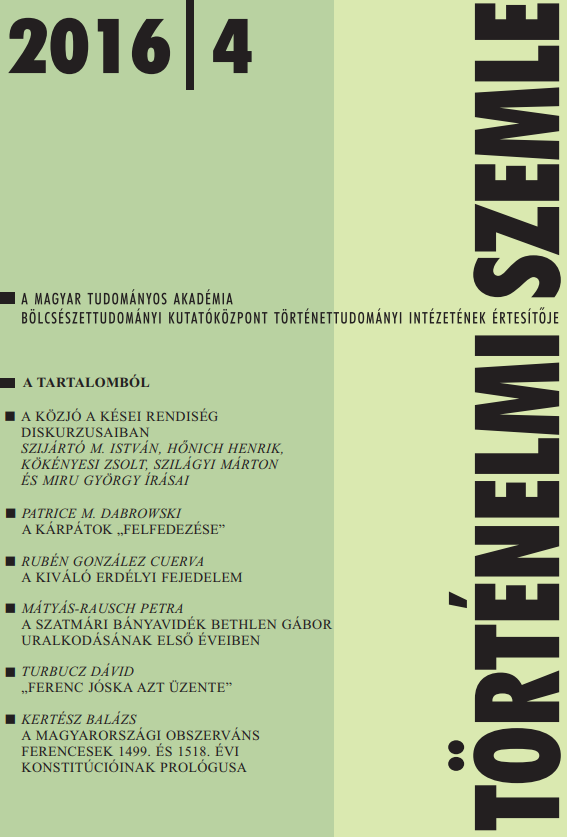A szatmári bányavidék Bethlen Gábor uralkodásának első éveiben (1613–1620)
The Mining Region of Szatmár in the First Years of Gábor Bethlen’s Rule (1613–1619)
Author(s): Petra Mátyás-RauschSubject(s): Economy, Economic history, 17th Century
Published by: Magyar Tudományos Akadémia Bölcsészettudományi Kutatóközpont Történettudományi Intézet
Keywords: The Mining Region of Szatmár; Gábor Bethlen; 1613–1619; Transylvanian Principality; Hungarian Kingdom;
Summary/Abstract: In the mid-16th century the mining region of Szatmár found itself squeezed to the borderland between the nascent Transylvanian Principality and the Hungarian Kingdom. Its belonging and position became doubtful once again after the death in 1613 of Gábor Báthory, the last Transylvanian prince from this family. As the area was crucially important to both sides from the perspective of both geopolitics and financial administration, the changes which took place over the mining region were profoundly influenced by contemporary politicomilitary events. Unwilling to give up the mining region on the borders, Matthias II, king of Hungary looked for a tenant to head the mining chamber and mining house of Nagybánya (today Baia Mare, Romania) whose loyalty to the dynasty would be in no doubt. It came quite conveniently for the Habsburgs, thus, that the faithful Herberstein family was restored to their estates in Szatmár at this critical juncture. Consequently, the Court Chamber (Camera Aulica) entrusted the direction of the mining chamber to the head of the family, Felician von Herberstein the Younger. Following in the footsteps of his father, the former lessee of Nagybánya, the younger Felician von Herberstein aimed to introduce several important changes into local mining, but these efforts ran counter to the interests of the urban leadership of Nagybánya. As the conflict between the urban magistracy and the tenant became increasingly envenomed, and the financial position of Herberstein had also catastrophically deteriorated by the late 1610s, his former supporters, among them the new captain of Upper Hungary, András Dóczy, abandoned him, and the count’s situation accordingly became untenable. Although the Court Chamber tried to find a new tenant, the first anti-Habsburg campaign of Gábor Bethlen, prince of Transylvania (1619–1621) decisively influenced the future of the mining region. In the winter of 1619 Bethlen conquered Nagybánya and the surrounding castles, and consequently removed Herberstein from his office. “Warfare” between Herberstein and the magistracy of Nagybánya was by no means a unique phenomenon; similar events were simultaneously acted out in other privileged mining towns as well. While not nationalized, Herberstein behaved in the same way as the contemporary urban nobility. He tried to exploit possibilities offered by urban privileges without submitting himself to the obligations and the jurisdictional consequences attached to urban existence. This obviously excited the magistracy of Nagybánya to act, and they defended the interests of the town with surprising determination.
Journal: Történelmi Szemle
- Issue Year: 2016
- Issue No: 04
- Page Range: 585-602
- Page Count: 18
- Language: Hungarian

